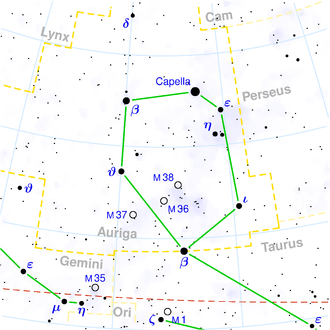Menkalinan
|
Double star Menkalinan (β Aurigae) |
|||||||||||||||||||||
|---|---|---|---|---|---|---|---|---|---|---|---|---|---|---|---|---|---|---|---|---|---|
| AladinLite | |||||||||||||||||||||
|
Observation dates equinox : J2000.0 , epoch : J2000.0 |
|||||||||||||||||||||
| Constellation | Carter | ||||||||||||||||||||
| Right ascension | 05 h 59 m 32 s | ||||||||||||||||||||
| declination | + 44 ° 56 ′ 51 ″ | ||||||||||||||||||||
| Apparent brightness | 1.90 (1.89 to 1.98) mag | ||||||||||||||||||||
| Typing | |||||||||||||||||||||
| B − V color index | (+0.03) | ||||||||||||||||||||
| U − B color index | (+0.04) | ||||||||||||||||||||
| R − I index | (−0.01) | ||||||||||||||||||||
| Spectral class | A2 IV + A2 IV-V | ||||||||||||||||||||
| Variable star type | EA / DM | ||||||||||||||||||||
| Astrometry | |||||||||||||||||||||
| Radial velocity | (−15.75 ± 0.62) km / s | ||||||||||||||||||||
| parallax | (40.21 ± 0.23) mas | ||||||||||||||||||||
| distance | (81 ± 1) ly (25) pc |
||||||||||||||||||||
| Visual absolute brightness M vis | (0.54 ± 0.10 / 0.70 ± 0.10) mag | ||||||||||||||||||||
| Proper movement | |||||||||||||||||||||
| Rec. Share: | (−56.44 ± 0.25) mas / a | ||||||||||||||||||||
| Dec. portion: | (−0.95 ± 0.11) mas / a | ||||||||||||||||||||
| Physical Properties | |||||||||||||||||||||
| Dimensions | (2.39 ± 0.01 / 2.33 ± 0.01) M ☉ | ||||||||||||||||||||
| radius | (2.77 ± 0.03 / 2.63 ± 0.03) R ☉ | ||||||||||||||||||||
| Luminosity | |||||||||||||||||||||
| Effective temperature | (9350 ± 200/9200 ± 200) K. | ||||||||||||||||||||
| Age | (570) mill. A | ||||||||||||||||||||
|
Other names and catalog entries |
|||||||||||||||||||||
|
|||||||||||||||||||||
Menkalinan ( Arabic : "shoulder of the one who holds the reins") is the name of the star β Aurigae (Beta Aurigae). The striking pentagon of the constellation Fuhrmann stands in Central Europe on winter evenings near the zenith, β is its second brightest star, about 6 ° east of the sparkling Capella .
Menkalinan is an eclipsing star of the Algol type , the brightness of which fluctuates between + 1.89 mag and + 1.98 mag with a period of 3.96 days. It was the second double star discovered by means of spectroscopy (see spectroscopic double star ). Both stars of Menkalinan belong to the spectral class A2. The system is about 80 light years away. Other spellings are Menkalinam, Menkarlinan, Menkarlina and Menkalina.
The star belongs to the so-called Bear Current , a loose cluster of about 150 stars distributed over half the sky, the brightest of which form the Big Dipper constellation . Our solar system is on the edge of this group, but is moving in a completely different direction.
See also
Web links
Individual evidence
- ↑ a b c d e f g h bet Aur. In: SIMBAD . Center de Données astronomiques de Strasbourg , accessed September 4, 2018 .
- ↑ a b c bet Aur. In: VSX. AAVSO, accessed September 4, 2018 .
- ↑ a b c d e B. Nordstrom, KT Johansen: Radii and masses for beta Aurigae . In: Astronomy & Astrophysics . 291, No. 3, 1994, pp. 777-785. bibcode : 1994A & A ... 291..777N .
- Jump up ↑ Bradford B. Behr, Andrew T. Cenko, Arsen R. Hajian, Robert S. McMillan, Marc Murison, Jeff Meade, Robert Hindsley: Stellar Astrophysics with a Dispersed Fourier Transform Spectrograph. II. Orbits of Double-lined Spectroscopic Binaries . In: The Astronomical Journal . 142, No. 1, July 2011, p. 6. arxiv : 1104.1447 . bibcode : 2011AJ .... 142 .... 6B . doi : 10.1088 / 0004-6256 / 142/1/6 .
